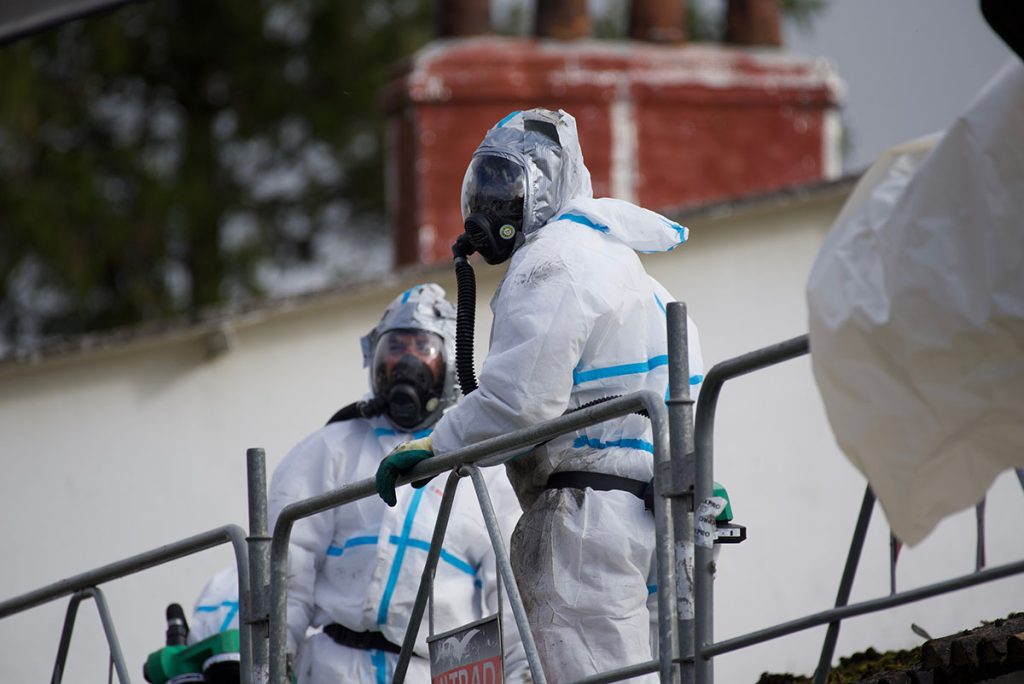
Hauts-de-France, France-October 25 2021: Asbestos removal from a rural school roof using specialist protective clothing and equipment.
What is Asbestos?
Asbestos is a group of minerals made up of tiny fibers. These fibers are strong, heat-resistant, and were once widely used in many industries. However, asbestos is now known to be very dangerous to human health.
How Asbestos Exposure Occurs in the Workplace
Workers can be exposed to asbestos in several ways. When materials containing asbestos are disturbed, tiny fibers can be released into the air. Workers might breathe in these fibers or get them on their skin or clothes. Jobs that involve cutting, sanding, or drilling asbestos-containing materials are especially risky.
Health Risks Associated with Asbestos Exposure
Exposure to asbestos can lead to serious health problems. Some of the main risks include:
- Asbestosis: A lung disease that causes scarring and makes it hard to breathe.
- Mesothelioma: A rare and aggressive cancer that affects the lining of the lungs, abdomen, or heart.
- Lung Cancer: Increased risk of lung cancer, especially for smokers.
These health issues often take years to develop, making early detection difficult.
High-Risk Industries for Asbestos Exposure
Construction and Demolition
Workers in construction and demolition are at high risk for asbestos exposure. This is because many older buildings contain asbestos materials. When these buildings are renovated or torn down, asbestos fibers can be released into the air. Workers may breathe in these fibers, which can lead to serious health problems over time.
Shipbuilding and Maritime
The shipbuilding and maritime industries have a long history of using asbestos. Asbestos was commonly used in ships for insulation and fireproofing. Workers who build, repair, or dismantle ships can be exposed to asbestos fibers. This exposure can happen when asbestos-containing materials are disturbed.
Manufacturing and Industrial Work
Many manufacturing and industrial jobs involve working with materials that contain asbestos. This includes making products like brake pads, roofing materials, and insulation. Workers in these industries can be exposed to asbestos fibers during the production process. This exposure can pose significant health risks if proper safety measures are not followed.
Identifying Symptoms of Asbestos-Related Diseases
Common Symptoms of Asbestosis
Asbestosis is a lung disease caused by inhaling asbestos fibers. People with asbestosis often have trouble breathing and may feel tightness in their chest. They might also have a dry, crackling sound in their lungs when they breathe. Over time, these symptoms can get worse, making it hard to do everyday activities.
Recognizing Mesothelioma
Mesothelioma is a rare cancer linked to asbestos exposure. It usually affects the lining of the lungs or abdomen. Symptoms can include chest pain, shortness of breath, and fluid buildup around the lungs. In the abdomen, it might cause pain, swelling, and weight loss. Because these symptoms are common in other illnesses, mesothelioma is often diagnosed late.
Other Asbestos-Related Conditions
Besides asbestosis and mesothelioma, asbestos exposure can lead to other health problems. These include lung cancer and pleural plaques, which are thickened patches on the lung lining. Symptoms of lung cancer from asbestos exposure are similar to other lung cancers, like coughing up blood and persistent cough. Pleural plaques usually don’t cause symptoms but can be seen on X-rays.
Legal Rights of Asbestos Exposure Victims
Filing a Workers’ Compensation Claim
Workers who have been exposed to asbestos on the job may be eligible to file a workers’ compensation claim. This type of claim can help cover medical expenses, lost wages, and other related costs. It’s important to report the exposure to your employer as soon as possible and seek medical attention immediately. Documentation from a healthcare provider can be crucial in supporting your claim.
Pursuing a Personal Injury Lawsuit
In some cases, victims of asbestos exposure may choose to file a personal injury lawsuit for mesothelioma. This legal action can be taken against manufacturers, employers, or other parties responsible for the exposure. A successful lawsuit can result in compensation for medical bills, pain and suffering, and other damages. Consulting with an attorney who specializes in asbestos-related cases can provide guidance on the best course of action.
Statute of Limitations for Asbestos Claims
It’s essential to be aware of the statute of limitations for filing asbestos-related claims. This is the time limit within which a claim must be filed, and it varies by state. Missing this deadline can result in losing the right to seek compensation. Therefore, it’s crucial to act promptly and consult with a legal professional to ensure all necessary steps are taken within the required timeframe.
Preventive Measures and Workplace Safety
Employer Responsibilities
Employers play a crucial role in preventing asbestos exposure in the workplace. They must follow safety regulations and ensure that their work environment is free from asbestos hazards. This includes regular inspections, proper maintenance, and immediate action if asbestos is found. Employers should also provide clear instructions and training to their employees about the dangers of asbestos and how to avoid exposure.
Protective Equipment and Safety Protocols
Using the right protective gear is essential for workers who might come into contact with asbestos. Employers should supply items like respirators, gloves, and protective clothing. Additionally, safety protocols must be in place to minimize exposure. These protocols can include wetting down asbestos materials to prevent dust, using proper ventilation systems, and ensuring that asbestos waste is disposed of safely.
Employee Training and Awareness Programs
Training programs are vital for educating workers about the risks of asbestos and how to protect themselves. These programs should cover how to identify asbestos, the health risks associated with exposure, and the correct use of protective equipment. Regular refresher courses can help keep this information fresh in employees’ minds. Awareness programs can also include posters, informational brochures, and meetings to discuss safety practices.
Resources and Support for Affected Workers
Medical Assistance and Health Monitoring
Workers exposed to asbestos need regular health check-ups. These check-ups help catch any health problems early. Doctors can monitor lung health and look for signs of diseases like asbestosis or mesothelioma. It’s important to follow the doctor’s advice and go to all appointments.
Legal Aid and Advocacy Groups
Victims of asbestos exposure have rights. Legal aid can help them understand these rights and take action. There are groups that offer free legal help. These groups can guide workers through the process of filing claims or lawsuits. They also work to protect workers’ rights and push for better laws.
Support Networks and Counseling Services
Dealing with asbestos-related diseases can be tough. Support networks offer a place to share experiences and get advice. Counseling services can help workers and their families cope with stress and anxiety. These services provide emotional support and practical tips for managing day-to-day life.






